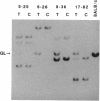Abstract
Attempts to grow primary murine plasmacytomas in vitro have, to date, been largely unsuccessful. In this study, we demonstrate that long-term in vitro growth of primary plasmacytomas is accomplished by using feeder layers composed of stromal cells from the initial site of plasmacytomagenesis. The early neoplastic lines established in this manner are dependent on physical contact with the stromal layer, which is mediated in part by CD44, for growth and survival. The stromal cells provide at least two stimuli for the plasma cells, one being interleukin 6 and the second, of unknown nature, resulting from direct physical interaction that cannot be replaced by soluble factors. These plasma cell lines have been passaged for as long as 20 months yet still maintain characteristics associated with primary plasmacytomas as they will grow in vivo only in pristane-primed animals, indicating a continued dependence on the pristane-induced microenvironment characteristic of early-stage tumors. The ability to grow primary plasmacytomas in culture and maintain their "primary" properties provides a model system for detailed analysis of early events in plasma cell tumor progression involving neoplastic cells completely dependent on physical contact with a stromal feeder layer for survival and expansion.
Full text
PDF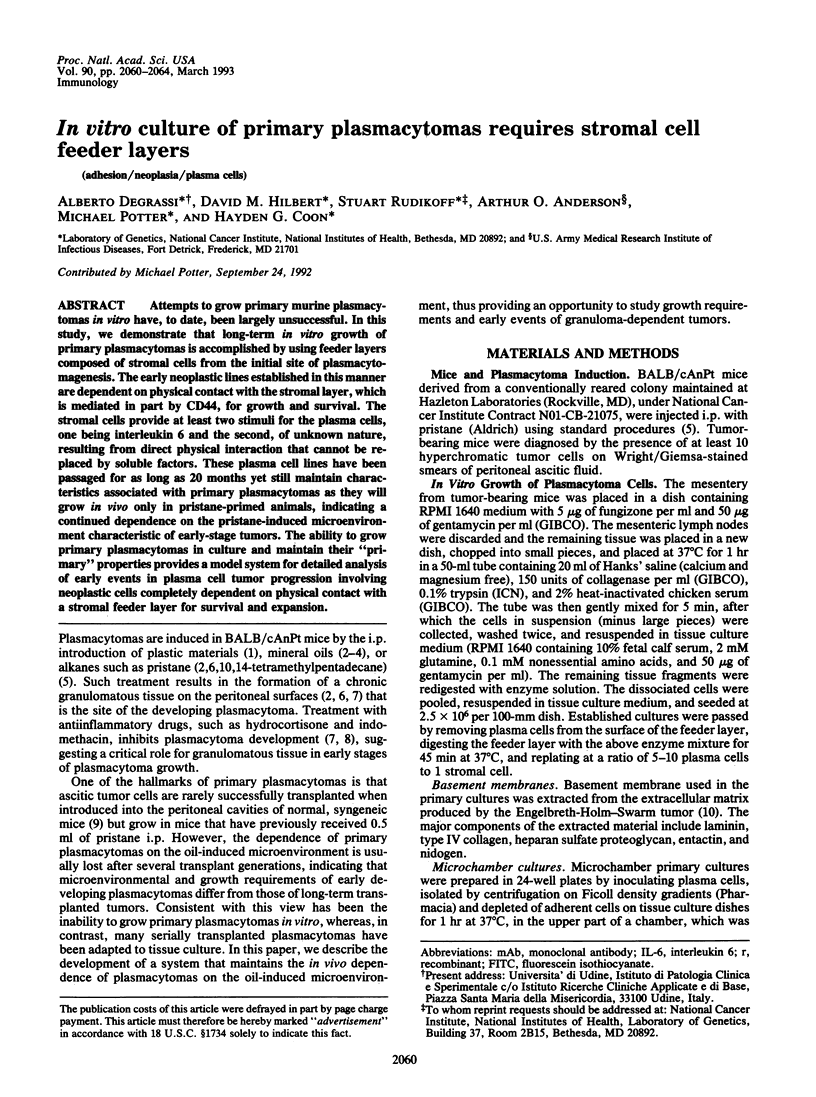
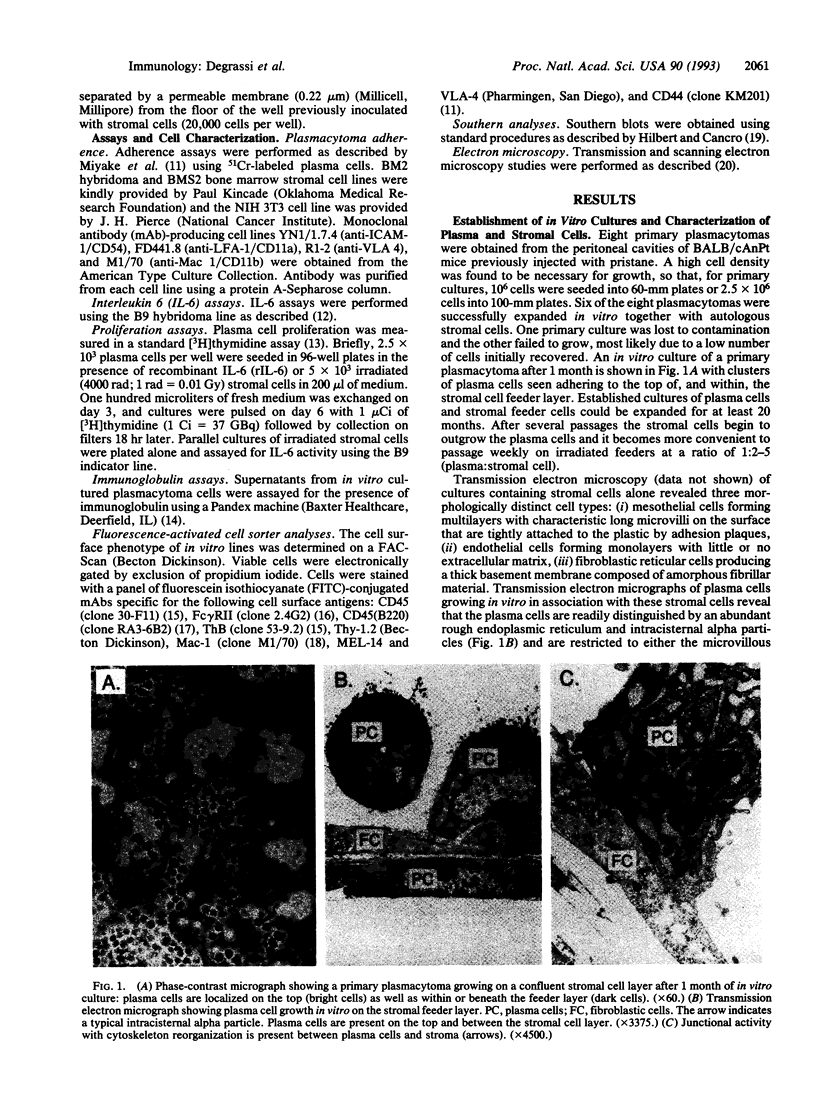
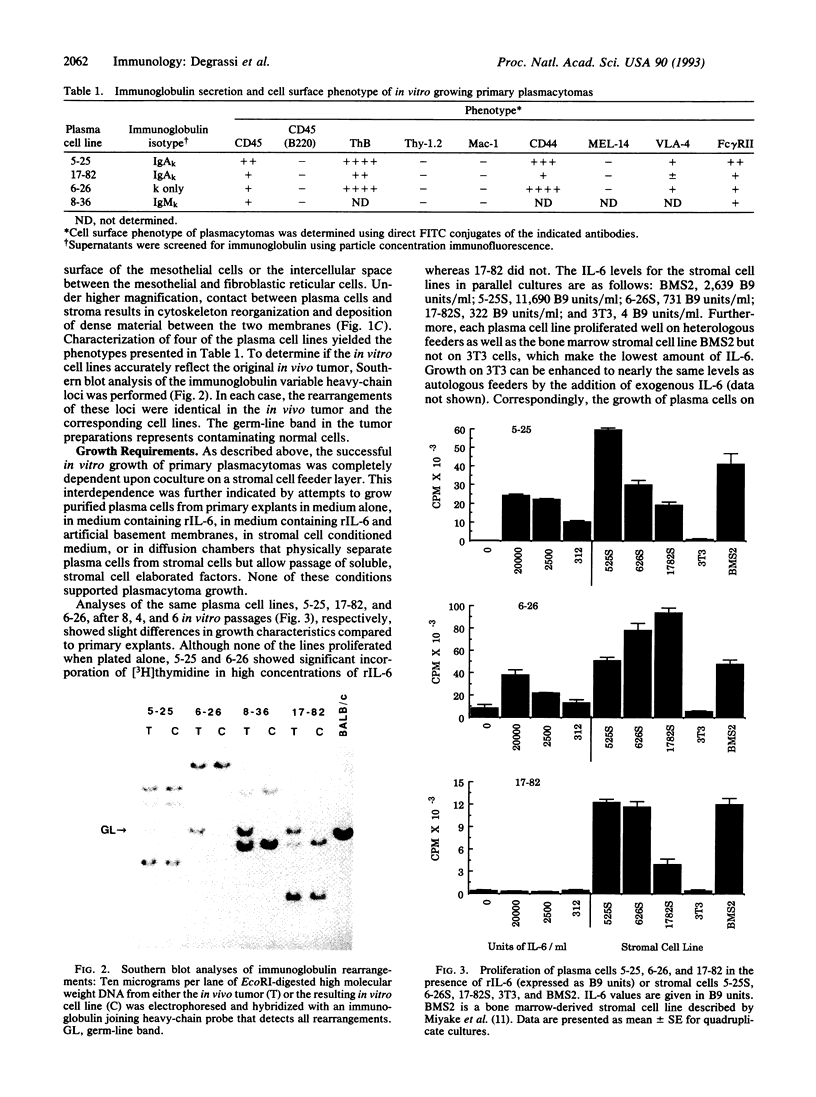
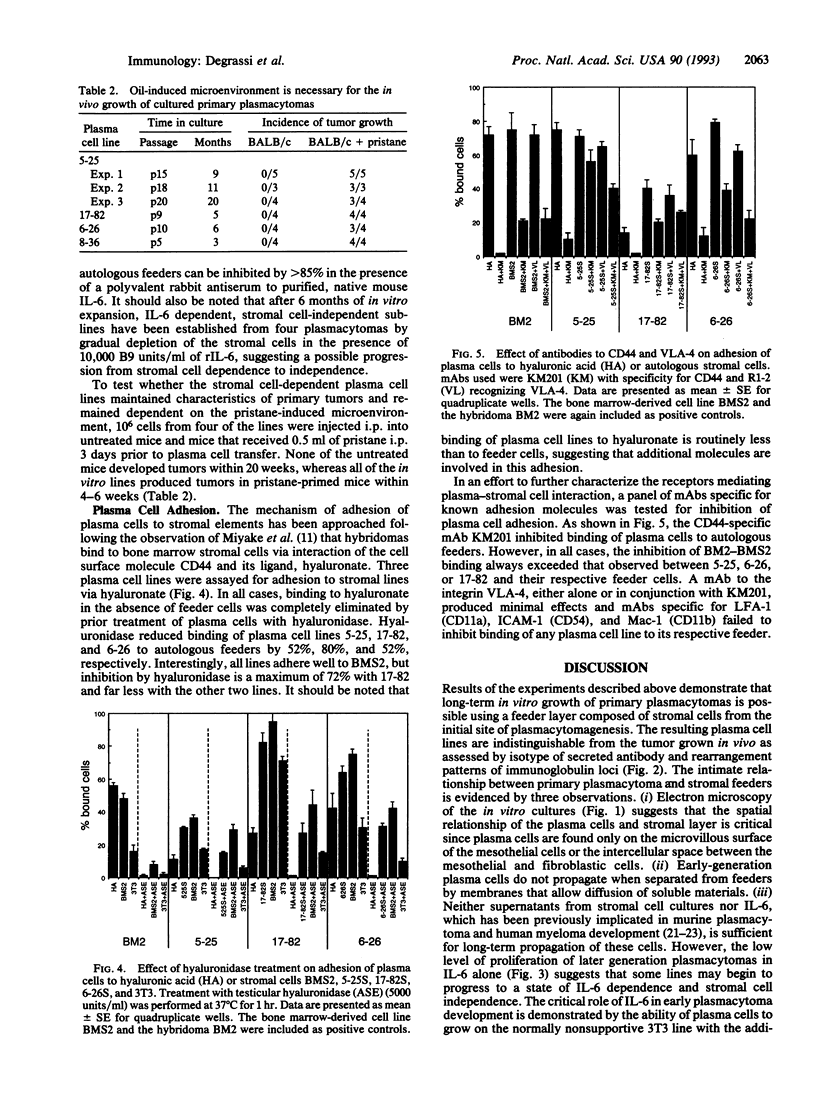
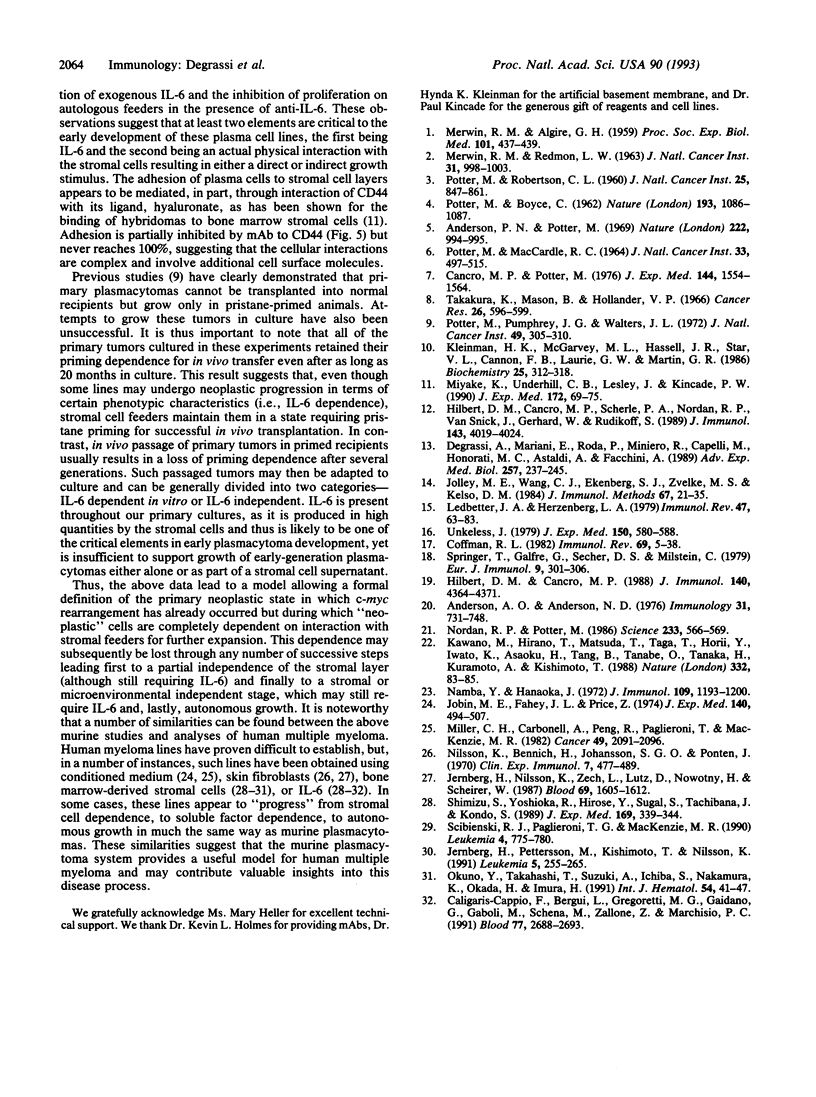
Images in this article
Selected References
These references are in PubMed. This may not be the complete list of references from this article.
- Anderson A. O., Anderson N. D. Lymphocyte emigration from high endothelial venules in rat lymph nodes. Immunology. 1976 Nov;31(5):731–748. [PMC free article] [PubMed] [Google Scholar]
- Anderson P. N., Potter M. Induction of plasma cell tumours in BALB-c mice with 2,6,10,14-tetramethylpentadecane (pristane). Nature. 1969 Jun 7;222(5197):994–995. doi: 10.1038/222994a0. [DOI] [PubMed] [Google Scholar]
- Caligaris-Cappio F., Bergui L., Gregoretti M. G., Gaidano G., Gaboli M., Schena M., Zallone A. Z., Marchisio P. C. 'Role of bone marrow stromal cells in the growth of human multiple myeloma. Blood. 1991 Jun 15;77(12):2688–2693. [PubMed] [Google Scholar]
- Cancro M., Potter M. The requirement of an adherent cell substratum for the growth of developing plasmacytoma cells in vivo. J Exp Med. 1976 Dec 1;144(6):1554–1567. doi: 10.1084/jem.144.6.1554. [DOI] [PMC free article] [PubMed] [Google Scholar]
- Coffman R. L. Surface antigen expression and immunoglobulin gene rearrangement during mouse pre-B cell development. Immunol Rev. 1982;69:5–23. doi: 10.1111/j.1600-065x.1983.tb00446.x. [DOI] [PubMed] [Google Scholar]
- Degrassi A., Mariani E., Roda P., Miniero R., Capelli M., Honorati M. C., Astaldi A., Facchini A. Specific lymphocyte proliferative response in vitro after cDNA HBsAg immunization. Adv Exp Med Biol. 1989;257:237–245. doi: 10.1007/978-1-4684-5712-4_23. [DOI] [PubMed] [Google Scholar]
- Hilbert D. M., Cancro M. P. Characterization of an inbred mouse exhibiting low responsiveness to phosphorylcholine. Antibodies from low-responder mice suggest gene conversion events within the S107VH gene family. J Immunol. 1988 Jun 15;140(12):4364–4371. [PubMed] [Google Scholar]
- Hilbert D. M., Cancro M. P., Scherle P. A., Nordan R. P., Van Snick J., Gerhard W., Rudikoff S. T cell derived IL-6 is differentially required for antigen-specific antibody secretion by primary and secondary B cells. J Immunol. 1989 Dec 15;143(12):4019–4024. [PubMed] [Google Scholar]
- Jernberg H., Nilsson K., Zech L., Lutz D., Nowotny H., Scheirer W. Establishment and phenotypic characterization of three new human myeloma cell lines (U-1957, U-1958, and U-1996). Blood. 1987 Jun;69(6):1605–1612. [PubMed] [Google Scholar]
- Jernberg H., Pettersson M., Kishimoto T., Nilsson K. Heterogeneity in response to interleukin 6 (IL-6), expression of IL-6 and IL-6 receptor mRNA in a panel of established human multiple myeloma cell lines. Leukemia. 1991 Mar;5(3):255–265. [PubMed] [Google Scholar]
- Jobin M. E., Fahey J. L., Price Z. Long-term establishment of a human plasmacyte cell line derived from a patient with IgD multiple myeloma. I. Requirement of a plasmacyte-stimulating factor for the proliferation of myeloma cells in tissue culture. J Exp Med. 1974 Aug 1;140(2):494–507. doi: 10.1084/jem.140.2.494. [DOI] [PMC free article] [PubMed] [Google Scholar]
- Jolley M. E., Wang C. H., Ekenberg S. J., Zuelke M. S., Kelso D. M. Particle concentration fluorescence immunoassay (PCFIA): a new, rapid immunoassay technique with high sensitivity. J Immunol Methods. 1984 Feb 24;67(1):21–35. doi: 10.1016/0022-1759(84)90082-6. [DOI] [PubMed] [Google Scholar]
- Kawano M., Hirano T., Matsuda T., Taga T., Horii Y., Iwato K., Asaoku H., Tang B., Tanabe O., Tanaka H. Autocrine generation and requirement of BSF-2/IL-6 for human multiple myelomas. Nature. 1988 Mar 3;332(6159):83–85. doi: 10.1038/332083a0. [DOI] [PubMed] [Google Scholar]
- Kleinman H. K., McGarvey M. L., Hassell J. R., Star V. L., Cannon F. B., Laurie G. W., Martin G. R. Basement membrane complexes with biological activity. Biochemistry. 1986 Jan 28;25(2):312–318. doi: 10.1021/bi00350a005. [DOI] [PubMed] [Google Scholar]
- Ledbetter J. A., Herzenberg L. A. Xenogeneic monoclonal antibodies to mouse lymphoid differentiation antigens. Immunol Rev. 1979;47:63–90. doi: 10.1111/j.1600-065x.1979.tb00289.x. [DOI] [PubMed] [Google Scholar]
- MERWIN R. M., ALGIRE G. H. Induction of plasma-cell neoplasms and fibrosarcomas in BALB/c mice carrying diffusion chambers. Proc Soc Exp Biol Med. 1959 Jul;101(3):437–439. doi: 10.3181/00379727-101-24970. [DOI] [PubMed] [Google Scholar]
- Miller C. H., Carbonell A., Peng R., Paglieroni T., MacKenzie M. R. A human plasma cell line: induction and characterization. Cancer. 1982 May 15;49(10):2091–2096. doi: 10.1002/1097-0142(19820515)49:10<2091::aid-cncr2820491021>3.0.co;2-9. [DOI] [PubMed] [Google Scholar]
- Miyake K., Underhill C. B., Lesley J., Kincade P. W. Hyaluronate can function as a cell adhesion molecule and CD44 participates in hyaluronate recognition. J Exp Med. 1990 Jul 1;172(1):69–75. doi: 10.1084/jem.172.1.69. [DOI] [PMC free article] [PubMed] [Google Scholar]
- Namba Y., Hanaoka M. Immunocytology of cultured IgM-forming cells of mouse. I. Requirement of phagocytic cell factor for the growth of IgM-forming tumor cells in tissue culture. J Immunol. 1972 Dec;109(6):1193–1200. [PubMed] [Google Scholar]
- Nilsson K., Bennich H., Johansson S. G., Pontén J. Established immunoglobulin producing myeloma (IgE) and lymphoblastoid (IgG) cell lines from an IgE myeloma patient. Clin Exp Immunol. 1970 Oct;7(4):477–489. [PMC free article] [PubMed] [Google Scholar]
- Nordan R. P., Potter M. A macrophage-derived factor required by plasmacytomas for survival and proliferation in vitro. Science. 1986 Aug 1;233(4763):566–569. doi: 10.1126/science.3726549. [DOI] [PubMed] [Google Scholar]
- Okuno Y., Takahashi T., Suzuki A., Ichiba S., Nakamura K., Okada T., Okada H., Imura H. In vitro growth pattern of myeloma cells in liquid suspension or semi-solid culture containing interleukin-6. Int J Hematol. 1991 Feb;54(1):41–47. [PubMed] [Google Scholar]
- POTTER M., BOYCE C. R. Induction of plasma-cell neoplasms in strain BALB/c mice with mineral oil and mineral oil adjuvants. Nature. 1962 Mar 17;193:1086–1087. doi: 10.1038/1931086a0. [DOI] [PubMed] [Google Scholar]
- POTTER M., MACCARDLE R. C. HISTOLOGY OF DEVELOPING PLASMA CELL NEOPLASIA INDUCED BY MINERAL OIL IN BALB/C MICE. J Natl Cancer Inst. 1964 Sep;33:497–515. [PubMed] [Google Scholar]
- POTTER M., ROBERTSON C. L. Development of plasma-cell neoplasms in BALB/c mice after intraperitoneal injection of paraffin-oil adjuvant, heart-killed Staphylococcus mixtures. J Natl Cancer Inst. 1960 Oct;25:847–861. doi: 10.1093/jnci/25.4.847. [DOI] [PubMed] [Google Scholar]
- Potter M., Pumphrey J. G., Walters J. L. Growth of primary plasmacytomas in the mineral oil-conditioned peritoneal environment. J Natl Cancer Inst. 1972 Jul;49(1):305–308. [PubMed] [Google Scholar]
- Scibienski R. J., Paglieroni T. G., MacKenzie M. R. Establishment and characterization of a CD5 positive, immunosuppressive human myeloma cell line. Leukemia. 1990 Nov;4(11):775–780. [PubMed] [Google Scholar]
- Shimizu S., Yoshioka R., Hirose Y., Sugai S., Tachibana J., Konda S. Establishment of two interleukin 6 (B cell stimulatory factor 2/interferon beta 2)-dependent human bone marrow-derived myeloma cell lines. J Exp Med. 1989 Jan 1;169(1):339–344. doi: 10.1084/jem.169.1.339. [DOI] [PMC free article] [PubMed] [Google Scholar]
- Springer T., Galfré G., Secher D. S., Milstein C. Mac-1: a macrophage differentiation antigen identified by monoclonal antibody. Eur J Immunol. 1979 Apr;9(4):301–306. doi: 10.1002/eji.1830090410. [DOI] [PubMed] [Google Scholar]
- Takakura K., Mason W. B., Hollander V. P. Studies on the pathogenesis of plasma cell tumors. I. Effect of cortisol on development of plasma cell tumors. Cancer Res. 1966 Apr;26(4):596–599. [PubMed] [Google Scholar]
- Unkeless J. C. Characterization of a monoclonal antibody directed against mouse macrophage and lymphocyte Fc receptors. J Exp Med. 1979 Sep 19;150(3):580–596. doi: 10.1084/jem.150.3.580. [DOI] [PMC free article] [PubMed] [Google Scholar]




